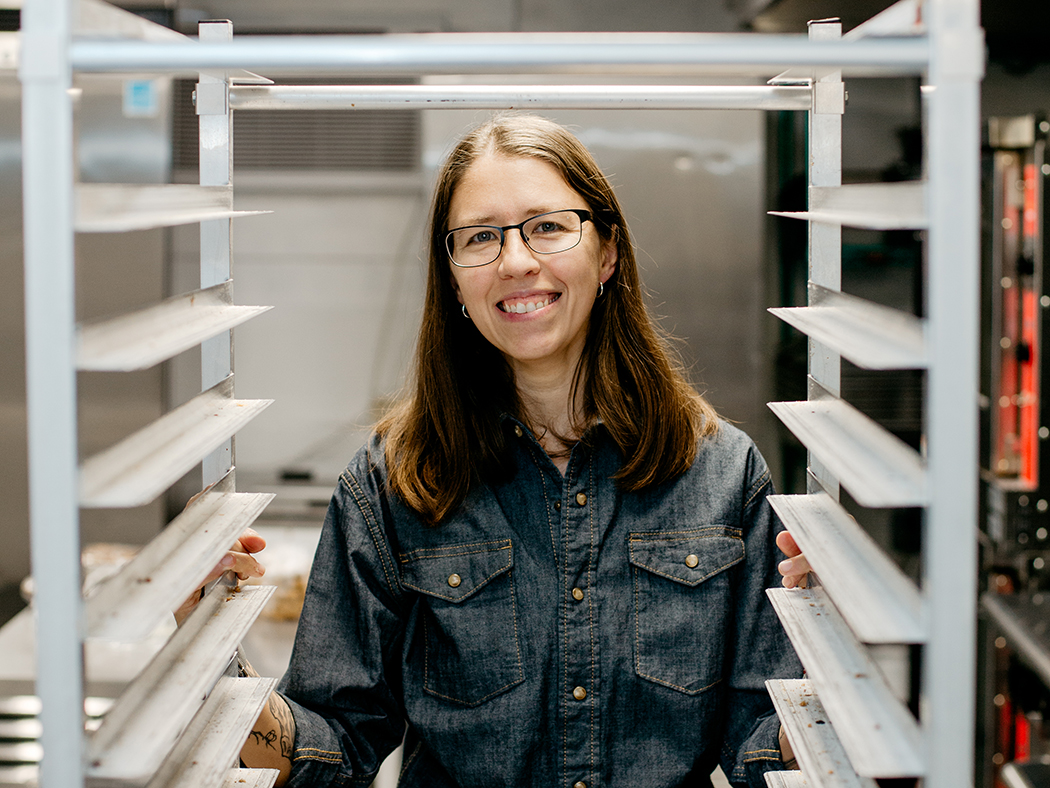By Julia Stumbaugh
In 2018, Charlottesville residents Jessica Niblo and Samuel Kane met for a first date at The Pie Chest. But they were both too nervous to eat the shop’s signature dish. Instead, they sipped coffee.
Three years later, in January 2021, Kane proposed to Niblo at the same spot where they’d first met. But like many of Charlottesville’s bakery/cafés, The Pie Chest had changed drastically. It was forced to pivot from the kind of community gathering spot where Kane and Niblo gazed at each other over cups of coffee to a purely commercial exchange of money for take-away boxes.
“I think a big part of The Pie Chest’s identity was the space we provided for people…it would get full pretty quickly, and a lot of people would end up talking to people they didn’t know,” says Rachel Pennington, baker and owner of the shop. “Losing that, going to fully carryout and takeout, it’s just heartbreaking. I think of it every time I’m up at the shop now. We’ve lost the buzz that can happen in the room, the connections that can happen…the whole social component is mostly gone.”
The Downtown Business Association of Charlottesville told NBC29 in December that COVID-19 had sliced business revenue in half through the 2020 holiday season. Even places that have been able to remain open have felt the sting, both from the loss of income and the loss of a place to gather.
In Charlottesville, a town defined by its love for food and drink, bakeries and coffee shops are a core part of the town’s social fabric.
“We’re able to stay open and survive, but it’s become more about commerce than community, which is kind of sad,” says Jason Becton, who opened MarieBette Café & Bakery with his husband, baker Patrick Evans. “Eventually, one day, we’ll come back to that.”
With the current closure of MarieBette’s dining room, what Becton misses most is the conversations and connections he used to find with regular customers. But like Pennington, he knows the changes are necessary to keep the business around.
“I think any business that’s been able to stay open is a comfort to people in our community, just because we crave that normalcy,” Becton said. “Even though it’s not quite normal, we try to be able to keep it as normal as possible.”
Thanks to an endless series of stay-at-home orders, home bakers across the United States have turned to their kitchens for comfort, trying viral recipes to make everything from sourdough bread to whipped coffee. But for bakers like Evans and Pennington, who have spent the last year baking to keep their shops afloat, the art is more about sustenance and less about fun.
Even so, their influence has led other local bakers to discover their own love of the craft. Pennington held a series of baking classes in 2019; now, she can turn to social media to see her students reap the benefits. One student displayed her fresh-made biscuits, still golden from the cast-iron skillet. Another posted an album featuring her Pie Chest-inspired veggie pot pie.
“Before I did it for a living, baking at home was absolutely comforting, not just in the process but in knowing that I was able to do something for other people and give them something that they would enjoy,” says Pennington. “So I still know what that feeling feels like.”
The search for that feeling helped spark a new addition to the Charlottesville bakery scene—Pear, a stall at the IX farmers’ market that opened in January 2021, is a local collaboration by two strangers whose only connection was that they both love to bake for people who love to eat.
Myo Quinn, co-founder of Pear, moved to Charlottesville from New York City this summer. Lonely and homesick, the Food Network test kitchen cook headed to the farmers’ market for a sense of normalcy. There she met Holly Hammond, who was working at the Whisper Hill Farm stall.
Quinn is a culinary school-trained chef, Hammond a farmer from Arizona. This winter, they opened their own bakery stall at the market where they met.
“We’ve had a lot of recurring customers, including friends of Holly’s and customers of Whisper Hill, that keep coming over and over again,” says Quinn. “We had our third weekend and the faces started looking familiar.”
Sharing her baking with newly familiar faces has allowed Quinn to weave herself into the fabric of the Charlottesville community. She and Hammond have learned through Pear what the owners of The Pie Chest and MarieBette know well: Even in a pandemic that forces people apart, baking can bring strangers together.
But for now, most of Charlottesville’s professional bakers are left dreaming of a time when their work involves more leisurely connections with customers.
“I long for the first day I can go into a coffee shop and just sit at a table and read the paper,” says Pennington. “I think about it at least once or twice a week. I just want to be part of the food community.”






